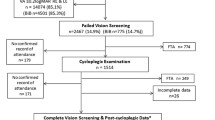Abstract
The purpose of this study was to determine the causes of childhood visual impairment and blindness in students of a school for blind children, to determine how many students had some residual vision, and to evaluate any unmet low-vision care. A survey of students in the blind school was conducted in two parts in May–June and then October 2003. The sample consisted of 201 students who became blind before the age of 16. Information was obtained from student interviews, doctors’ referral notes and ophthalmic examination of all students who consented. Students with residual vision had low-vision assessments. These investigations were supplemented with active participation of the investigators in Parent–Teacher Association meetings and focus group discussions with parents. One hundred and ninety-nine students consented and were recruited, whereas two declined. Ninety-six became visually impaired within their first year of life and 33 by the age of 5 years. Pathology of the cornea and then the lens were the commonest causes of blindness. One hundred and eight students were totally blind, whereas 87 (43.7%) had some residual vision and formed the target for the second part of the study. Fifty-one out of 77 of this target group who turned up for low-vision examination had useful residual vision by the World Health Organisation (WHO) low-vision examination chart. Spectacle magnifiers aided two students to read normal print at N5 and N8, respectively. Different visual aids would help enhance the residual vision in some of the others. Emotional trauma was apparent in parents and teachers. Children who became blind later in life remained in shock for a longer time and adapted less well to their visual impairment. Visual impairment in the population is not uncommon. Some causes are preventable. There is a significant unmet need for low-vision care, particularly amongst children in Ghana, and perhaps many countries in the West Africa subregion. It is hoped that the findings from this study will help spur sustained interventions.
Similar content being viewed by others
Notes
personal observation of the first author during a study tour [sponsored by Sight Savers International (SSI) of the school
January 2006
Low Vision Services Provided by the Low Vision Project-Kenya. http://icevi.org/publications/icevix/workshops/0262.html. Downloaded October 2005
References
World Health Organization. Preventing blindness in children: report of WHO/IAPB scientific meeting. Geneva: WHO, 2000 (WHO/PBL/00.77.)
Gilbert CE, Anderton L, Dandona L et al (1999) Prevalence of blindness and visual impairment in children—a review of available data. Ophthalmic Epidemiol 6:73–81
Roibeard OE (2003) WHO Initiative targets childhood blindnerss. Eye to eye supplement. January 2003
Gilbert C, Awan H (2003) Editorial: Blindness in children. BMJ 327:760–761
World Health Organization. Global initiative for the elimination of avoidable blindness. Geneva: WHO, 1977 (WHO/PBL/97.61.)
Faal H (2004) Welcome message to IAPB General Assembly in Dubai, in September 2004. Editorial IAPB News October 44:3
Akafo SK, Hagan M (1990) Causes of childhood blindness in Southern Ghana–a blind school survey. Ghana Med J 24:113–119
Gilbert CE, Canavas R, Hagan M et al (1993) Causes of childhood blindness results from West Africa, South India and Chile. Eye 7:184–88
Office of Population Census and Surveys (1991). Standard occupational classification, vol 3. Govt Statistical Service. HMSO, London
Courtright P, Chirambo M, Lewallen S, Harjinder C, Kanjaloti S (2000) Collaboration with African traditional healers for the prevention of blindness. World Scientific Publication, Singapore
Ntim-Amponsah CT, Amoaku WMK, Ofosu-Amaah S (2005) Alternate eye care services in a Ghanaian District. Ghana Med J 39:19–23
Hagan M, Wright E, Newman M, John P et al (1995) Causes of suppurative keratitis in Ghana. Br J Ophthalmol 79:1024–1028
Leck AK, Thomas PA, Hagan M, Kaliamurthy J et al (2002) Aetiology of suppurative corneal ulcers in Ghana and South India, and epidemiology of fungal keratitis. Br J Ophthalmol 86:1211–1215
Ntim-Amponsah CT (1995) Traditional methods of treatment of cataract seen at Korle-Bu Teaching Hospital. West Afri J of Med 14:84–87
Kello AB, Gilbert C (2003) Causes of severe visual impairment and blindness in children in schools for the blind in Ethiopia. Br J Ophthalmol 87:526–530
Acknowledgments
We acknowledge financial support from East Legon Pharmacy, Ghana. We are grateful to the head teacher and staff of the Akropong School for the Blind, Kwabena Ntim-Amponsah, Dr. R K Ewusi, Dr. S Y Adam, Dr. A. Osafo-Kwaako, and Mr. George Afenyo, for their contributions to the survey. We are also grateful to the students and their parents for their cooperation.
Author information
Authors and Affiliations
Corresponding author
Rights and permissions
About this article
Cite this article
Ntim-Amponsah, C.T., Amoaku, W.M.K. Causes of childhood visual impairment and unmet low-vision care in blind school students in Ghana. Int Ophthalmol 28, 317–323 (2008). https://doi.org/10.1007/s10792-007-9134-x
Received:
Accepted:
Published:
Issue Date:
DOI: https://doi.org/10.1007/s10792-007-9134-x




